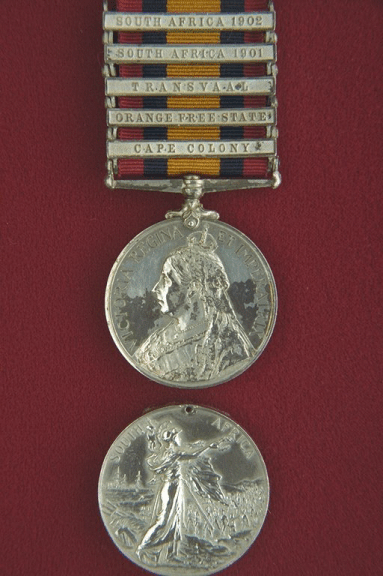Contributors
Campaign Stars and Medals (1866-1918)
Queen's South Africa Medal
Context
This South African War medal was authorized in 1900.
Eligibility and criteria
The medal was awarded to all who served in South Africa between 11 October 1899 and 31 May 1902.
Description
A circular, silver medal, 1.42 inches in diameter. For mounting, a plain, straight suspender is attached to the medal with a double-toe claw.
The obverse shows a crowned and veiled effigy of the Queen Victoria, facing left, with the legend VICTORIA REGINA ET IMPERATRIX.
On the reverse Britannia is depicted holding the Union Flag in her left hand and a laurel wreath in her right hand. In the right background are troops marching to the coast and in the left background are two men-of-war. Around the top are the words SOUTH AFRICA. The first medals, awarded to the LSH, bore the dates 1899 - 1900. The dates were removed from subsequent medals because the war continued beyond 1900. Some medals still show the 'ghost' of 1899 - 1900.
Ribbon
The ribbon is 1.25 inches wide, and consists of five stripes: red, dark blue, orange centre, dark blue, and red.
Bars
There are twenty-six bars to the medal. Those awarded to Canadians most often were:
Cape Colony: Awarded to troops serving in Cape Colony between 11 October 1899 and 31 May 1902;
Orange Free State: Awarded to troops serving in Orange River Colony any time from 28 February 1900 to 21 May 1902;
Johannesburg: Awarded to those troops who, on 29 May 1900, were north of an east and west line through Klip River Station and east of a north and south line through Krugersdorp Station.
Belfast: Awarded to troops who, on 26 or 27 August 1900, were east of a north and south line drawn through Wonderfonein, and west of a north and south line through Dalmanutha Station, and north of an east and west line drawn through Carolina;
Transvaal: Awarded to those troops serving in the Transvaal at any time between 24 May 1900 and 31 May 1902, who received no other clasp for action in the Transvaal;
Natal: Awarded to all troops serving in Natal between 11 October 1899 and 11 June 1900;
Driefontein: Awarded to troops serving with Army Headquarters and LGen French's column which advanced from Poplar Grove on 10 March 1900;
South Africa 1901: Awarded to those not eligible for the King's Medal although they had served at the front between 01 January and 31 December 1901;
South Africa 1902: Awarded to those not eligible for the King's Medal although they had served at the front between 01 January and 31 May 1902.
The other bars, awarded less frequently to Canadians, were:
Rhodesia; Relief of Mafeking; Defence of Ladysmith; Belmont; Modder River; Elandslaagte; Tugela Heights; Relief of Kimberley; Relief of Ladysmith; Wepener; Defence of Mafeking; Laing’s Nek; Diamond Hill; Wittebergen; Paardeberg.
Historical notes
- There were 3,860 medals awarded to Canadians. Fifty of the 418 presented to the Lord Strathcona's Horse (LSH) on 15 February 1901 are known to have the dates 1899 - 1900 on the reverse. As many as 300 medals may have had the dates.
- Naming is an indented block or sloping capitals
- (e.g., 4 RSM J. HYNES LD. STRATHCONA'S H:).
- Date modified:
